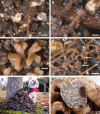Successes and challenges in the sustainable cultivation of edible mycorrhizal fungi - furthering the dream
- PMID: 37090021
- PMCID: PMC9157773
- DOI: 10.47371/mycosci.2020.11.007
Successes and challenges in the sustainable cultivation of edible mycorrhizal fungi - furthering the dream
Abstract
The cultivation of edible mycorrhizal fungi (EMF) has made great progress since the first cultivation of Tuber melanosporum in 1977 but remains in its infancy. Five cultivation steps are required: (1) mycorrhizal synthesis, (2) mycorrhiza development and acclimation, (3) out-planting of mycorrhizal seedlings, (4) onset of fructification, and (5) performing tree orchards. We provide examples of successes and challenges associated with each step, including fruiting of the prestigious chanterelles in Japan recently. We highlight the challenges in establishing performing tree orchards. We report on the monitoring of two orchards established between Lactarius deliciosus (saffron milk cap) and pines in New Zealand. Saffron milk caps yields reached 0.4 and 1100 kg/ha under Pinus radiata and P. sylvestris 6 and 9 y after planting, respectively. Canopy closure began under P. radiata 7 y after planting, followed by a drastic reduction of yields, while P. sylvestris yields still hovered at 690 to 780 kg/ha after 11 y, without canopy closure. The establishment of full-scale field trials to predict yields is crucial to making the cultivation of EMF a reality in tomorrow's cropping landscape. Sustainable EMF cultivation utilizing trees in non-forested land could contribute to carbon storage, while providing revenue and other ecosystem services.
Keywords: Lactarius deliciosus; ecosystem services; forest mushroom; orchard; truffle.
2021, by The Mycological Society of Japan.
Conflict of interest statement
The author declares no conflict of interest.
Figures









References
-
- Águeda, B., Parladé, J., Fernández-Toirán, L. M., Cisneros, O., de Miguel, A. M., Modrego, M. P., Martínez-Peña, F., & Pera, J. (2008). Mycorrhizal synthesis between Boletus edulis species complex and rockroses (Cistus sp.). Mycorrhiza, 18, 443–449. https://link.springer.com/article/10.1007/s00572-008-0192-3 - PubMed
-
- Alexander, S. J., Pilz, D., Weber, N. S., Brown, Ed., & Rockwell, V. A. (2002). Mushrooms, trees, and money: value estimates of commercial mushrooms and timber in the Pacific Northwest. Environmental Management, 30, 129–141. https://link.springer.com/article/10.1007/s00267-002-2610-1 - PubMed
-
- Álvarez-Lafuente, A., Benito-Matías, L. F., Peñuelas-Rubira, J. L., & Suz, L. M. (2018). Multi-cropping edible truffles and sweet chestnuts: production of high-quality Castanea sativa seedlings inoculated with Tuber aestivum, its ecotype T. uncinatum, T. brumale, and T. macrosporum. Mycorrhiza, 28, 29–38. 10.1007/s00572-017-0805-9 - DOI - PubMed
-
- Amicucci, A., Zambonelli, A., Giomaro, G., Potenza, L., & Stocchi, V. (1998). Identification of ectomycorrhizal fungi of the genus Tuber by species-specific ITS primers. Molecular Ecology, 7, 273–277.
Publication types
LinkOut - more resources
Full Text Sources
Miscellaneous
